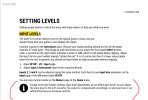TommyVonVoigt
Member
Question - if I reduce my rack down from 8 spaces to 6, that would have the Axe sitting right on top of the Fryette 2502 power amp. The Fryette doesn't exactly give off space heater levels of heat, but still, it gets warm. Is there any reason to be concerned about having the Axe racked directly above the power amp?



 and
and  .
.